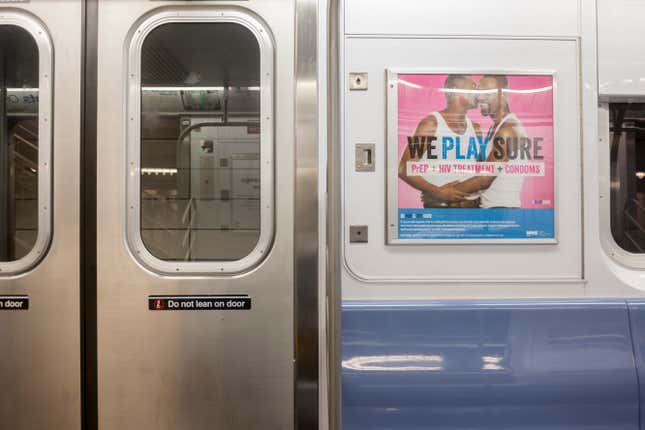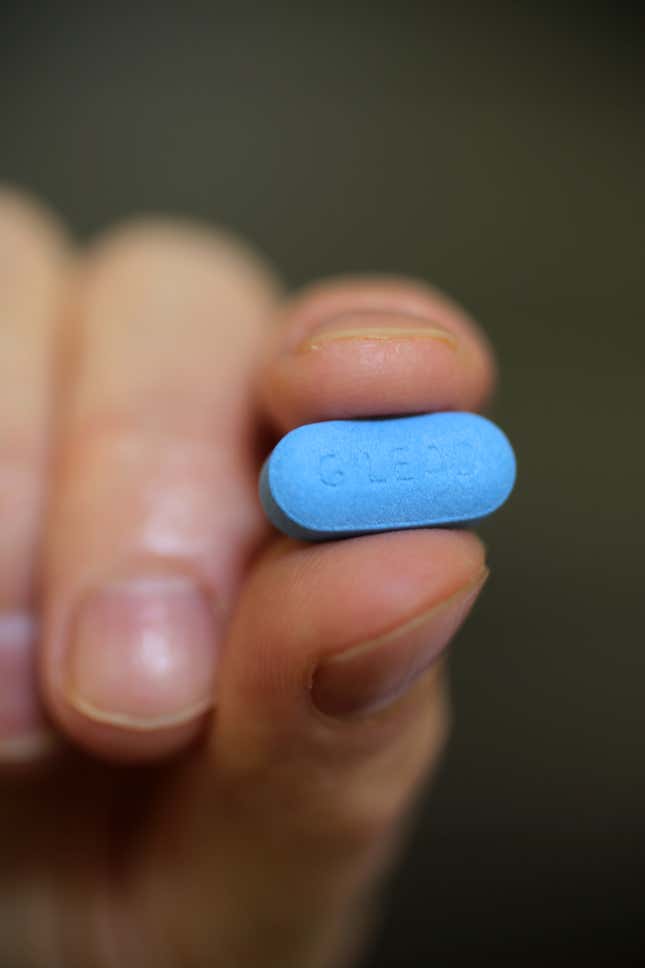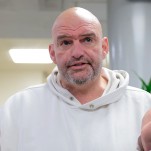PrEP Gave Us a Tool for Ending HIV, But It Has Failed to Deliver
On its 10th anniversary, queer, Black, and Latinx communities are calling attention to the unfulfilled promise of this groundbreaking medication.
In DepthIn Depth
Illustration: Rebecca Fassola
A few years ago, maybe 2016 or 2017, Kenyon Farrow traveled to Atlanta for work, where one of his Lyft drivers was an older Black woman. She struck up a conversation regarding why he was in town, and he told her about his work in HIV advocacy. He mentioned PrEP, the healthcare regimen that includes taking medication to prevent HIV transmission. The driver was confused initially and then curious: How long had this prevention tool been available? Farrow explained that the FDA had approved the first antiretroviral medication for PrEP in 2012. At that point, she started crying so hard she had to pull the car over. Then she explained that her two gay nephews, at the time aged 21 and 25, had been diagnosed with HIV in the years since. Their infections could have been prevented by PrEP but, as Farrow, the managing director of advocacy and organizing at PrEP4All, put it to Jezebel in a recent interview, “People didn’t know about it.”
If only those two young men were exceptions. Perhaps then the 10th anniversary of the FDA’s approval of Truvada for PrEP, or pre-exposure prophylaxis, on July 16, 2012, might be a cause to celebrate. It could have been an opportunity to look back on how a biomedical intervention altered queer culture and helped eradicate HIV once and for all. With 99 percent effectiveness with consistent adherence—which for the bulk of the past 10 years meant sticking to a daily pill, as well as doctor’s visits every three months and regular lab work—PrEP is theoretically as useful as a vaccine against HIV.
Those who adhere to PrEP’s somewhat rigorous regimen do have, it seems, a different outlook on sexuality. A few years ago, an article I wrote attributed the rise of public sex in New York’s queer spaces in part to PrEP. Public sex among predominantly men who have sex with men has only become a bigger reality in New York nightlife, with several recurring parties hosting back rooms. But sheer data suggests that said sexual liberation—“Sex Without Fear,” as Tim Murphy’s seminal 2014 New York article described it—remains reserved for a privileged class.

“America cannot consider PrEP a success until we see utilization of it in Black America,” Leisha McKinley-Beach, an HIV/AIDS consultant of more than 30 years, told Jezebel. Vincent Guilamo-Ramos, dean of Duke University’s School of Nursing and lead author of a 2020 article describing the HIV crisis among Latino people as “invisible,” said, “I think that the path forward is really recognizing that the Latino community increasingly is going to be a larger proportion of the overall U.S. population.” According to the Centers for Disease Control and Prevention, rates of new HIV infections among Black people are eight times as high as they are in white people, while Latinx people experience rates four times higher than whites. Meanwhile, Black and Latinx people are far less likely than white people to be prescribed and stick with PrEP (what those in the biz call “uptake”). According to the CDC, 1.2 million people in America should be on PrEP, a net the agency casts based on demographic and behavioral data. In total, only a quarter of those 1.2 million people were ultimately prescribed PrEP by their doctors in 2020—woefully short of making an impact on new HIV infections, which have fallen slowly in the U.S. over the last 10 years. (Overall new infection rates in the U.S. from 2010 to 2019 declined just 22.5 percent, from 47,500 in 2010 to 36,800 in 2019.) Dig into the numbers further, and you’ll find that 66 percent of white people recommended for PrEP got prescriptions, compared to 16 percent of Latinx people and 9 percent of Black people. The advocates, researchers, and public health experts Jezebel spoke to pointed out many potential explanations—like doctors not effectively putting their nonwhite patients on PrEP—that together have created barriers to HIV prevention, a kind of prophylaxis for prophylaxis.
Longtime HIV/AIDS activist Mark Harrington, who joined ACT UP in 1988 and co-founded Treatment Action Group in 1992, called PrEP “one of the biggest disappointments of the entire AIDS pandemic for me,” during an interview with Jezebel. “Most of the world, including the U.S., has really missed out on an opportunity to make a huge difference in HIV transmission over the last ten years,” he continued. Dázon Dixon Diallo, an AIDS advocate since 1989 and the founder of the Atlanta-based SisterLove, the first women’s HIV/AIDS and reproductive justice organization in the Southeastern U.S., told Jezebel that PrEP’s biggest success is “proof of concept” that HIV can be biomedically prevented. But it is still, Farrow said, a “failure in the grand scheme of things.”
It Is More Than a Gay White Man’s Disease
So what went wrong? On one level, there were philosophical misgivings from the beginning. PrEP’s approval set off debates among queer men regarding ethics and responsible use, as this biomedical intervention threatened the prevailing “condom code” that equated latex with morality. “We had this amazing news: ‘Hey, look, the thing is 99 percent effective,’ and the community’s response is to make it a debate,” said James Krellenstein, founder of the PrEP4All advocacy group (and, full disclosure, a close friend of mine). “It just doesn’t make sense. Why did it take us how many years to call out Larry Kramer for this?” Writer-activist Kramer, who died in 2020, had long been a divisive presence in gay culture, though by the 2010s, his profile was probably more on the revered grande dame side of things than that of a vilified hypocrite. His views expressed in a 2014 New York Times interview summed up the anti-PrEP position’s virtual incoherence: “There’s something to me cowardly about taking Truvada instead of using a condom,” he said. He also claimed that “anybody who voluntarily takes an antiviral every day has got to have rocks in their heads.” Kramer soon changed his position to be (warily) pro-PrEP.
“We had this amazing news: ‘Hey, look, the thing is 99 percent effective,’ and the community’s response is to make it a debate.”
Further convoluting the message, McKinley-Beach said, is that when HIV and AIDS received major cultural coverage, it tended to focus on how the disease affected white people—think Philadelphia, How to Survive a Plague, And the Band Played On, and The Normal Heart. “There are still some people who believe that this is a gay white male’s disease,” she said.
Even before the public debate, though, there were bias issues, as early research benefitted white gay men. Louis Shackelford, external relations project manager at the HIV Vaccine Trials Network (based out of Fred Hutchinson Cancer Center in Seattle), said researchers remain privileged and paternalistic. The importance of studying different groups of men who have sex with men is “not because our bodies are necessarily different,” Shackelford said. Biologically, PrEP works for white, Black, Latinx, and any other cis man equally. “It’s just because we didn’t get a chance to say how to best implement PrEP,” he continued. “PrEP implementation for a white community may just mean putting billboards up and letting people go to the doctor. For a Black community, it may mean going to community centers and doing education in certain ways, or giving presentations to certain community leaders so they can distribute the information to people that they’re connected to.”
-

-

-

-

-

-

-

-

-

-

-

-

-

-

-

-

-

-

-

-

-

-

-

-

-

-

-

-

-

-

-

-

-

-

-

-

-

-

-

-









































